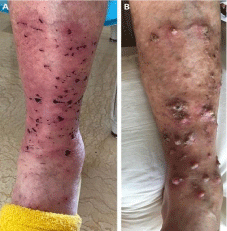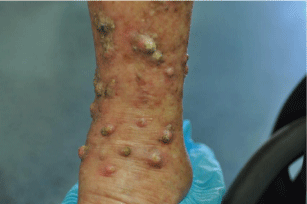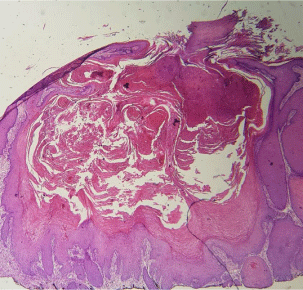
Case Report
Austin J Clin Case Rep. 2021; 8(2): 1197.
Keratoacanthomas Induced by Cat Scratches in an Elderly Woman
Alawami AZ*, El Hakim JJ and Tannous ZS
Dermatology Division, Lebanese American University Medical Center-Rizk Hospital, Lebanon
*Corresponding author: Alawami AZ, Department of Dermatology, LAU Medical Center-Rizk Hospital, P.O. Box 11-3288, Beirut, Lebanon
Received: February 03, 2021; Accepted: February 27, 2021; Published: March 06, 2021
Abstract
Background: Keratoacanthomas (KAs) are relatively common self-limited squamous proliferations. It is a matter of debate, whether they are a variant of squamous cell carcinoma or benign neoplasms. The exact etiology is uncertain, but is believed to be multifactorial, and is reportedly associated with trauma. This report describes an elderly woman with multiple keratoacanthomas developing at sites scratched by a pet cat.
Methods: A case of a 92-year-old woman with Alzheimer’s disease, presented with multiple rapidly growing, bizarre looking lesions on the left leg. The lesions appeared several weeks after being scratched by a cat.
Results: Tissue cultures for bacteria, fungi and atypical mycobacteria were negative. Histopathologic examination was consistent with keratoacanthoma.
Conclusion: The development of Keratoacanthomas (KAs) have been associated with actinic damage, genetic susceptibility, carcinogens, immunosuppression and viruses. It also seems that keratoacanthoma has predilection for sites with previous trauma. Our case is a further evidence that trauma and keratoacanthoma are closely related.
Keywords: General dermatology; Dermatopathology; Cutaneous oncology; Keratoacanthoma
Case Presentation
A 92-year-old woman with Alzheimer’s disease, presented with multiple rapid growing lesions on the left leg. The lesions appeared several weeks after being scratched by a cat. Due to her sensoryperceptual alteration, she didn’t respond physically or verbally to the excessive scratching. When the caregiver noticed the erosions on the patient’s leg (Figure 1A), she consulted her general physician. The latter prescribed oral amoxicillin/clavulanate and topical fusidic acid. This resulted in reduction of the erythema. However, bizarre looking lesions grew rapidly over the course of several weeks (Figure 1B).

Figure 1: The patient had numerous dome-shaped, skin-colored to
erythematous, nodules and tumors with keratin plug on the left anterior lower
leg (B) that appeared several weeks after being scratched by a cat (A).
On physical examination, the patient had numerous domeshaped, skin-colored to erythematous, nodules and tumors with keratin plug on the left anterior lower leg (Figure 2). Tissue cultures for bacteria, fungi and atypical mycobacteria were negative. Histopathologic examination demonstrated an exoendophytic lesion with lateral collarette, keratin plug and underlying well-differentiated squamous epithelium, consistent with keratoacanthoma (Figure 3). Two large keratoacanthomas were surgically excised. Spontaneous regression of the small tumors was observed five weeks later.

Figure 2: Close-up view demonstrating central keratinous plugs on the lesions.

Figure 3: Biopsy specimen showing an exoendophytic lesion with lateral
collarette, keratin plug, and underlying proliferating well-differentiated
squamous epithelium. (Hematoxylin-eosin stain; original magnification, x5).
Discussion
Keratoacanthomas (KAs) are relatively common self-limited squamous proliferations. It is a matter of debate, whether they are a variant of squamous cell carcinoma or benign neoplasms [1]. Clinically, they are characterized by rapid development, often compared to a little volcano, and spontaneous regression. They are usually solitary and rarely eruptive, in the form of generalized eruptive keratoacanthomas (Grzybowski syndrome) or the inherited disease: multiple self-healing squamous epitheliomas of Ferguson-Smith.
Three evolutionary stages of keratoacanthoma have been described. The early lesion is usually small with scant keratinization and inflammation. A fully established lesion is characterized clinically by a central keratin plug and identified histologically by the typical crateriform architecture and deep bulbous well-differentiated squamous epithelium with abundant glassy eosinophilic cytoplasm. In contrast, the regressing keratoacanthoma loses the crater-like qualities and becomes shallow like a comedo or a cyst on histologic sections [1]. Eventually, the lesion heals with a scar.
Keratoacanthoma commonly erupts on sun exposed areas with signs of actinic damage. In a large prospective study, it was suggested that ultraviolet radiation, older age (≥60 years), male sex, smoking and high alcohol use are independent risk factors for the development of keratoacanthoma [2]. The exact etiology is uncertain but is believed to be multifactorial, including ultraviolet B radiation, genetic susceptibility, carcinogens, immunosuppression and viruses. It also seems that keratoacanthoma has predilection for sites with previous trauma. Interestingly, there are reports depicting the association between keratoacanthoma appearance and prior skin grafting, thermal burn, vaccination, razor cut and mosquito bite, although the mechanism underlying this association is not clearly understood [3]. It has been suggested that in a genetically predisposed individual, an initiation phase, possibly triggered by ultraviolet radiation, with subsequent trauma acting as a promoter, may potentially induce tumor development [3].
Surgical excision remains the gold standard for solitary keratoacanthoma, however there is no consensus on what constitutes an adequate margin. As with noninvasive SCC, a 5mm margin can be advised to assure 95% chance of tumor clearance. Given the possibility of spontaneous resolution, watchful waiting might also be considered. The treatment of multiple and large keratoacanthomas is challenging. The first line option is systemic acitretin or other retinoids, as monotherapy or in conjunction with surgery. There are limited reports about the efficacy of intralesional therapy, including the use of corticosteroids, fluorouracil and methotrexate. Other systemic therapies that have been used with limited efficacy include methotrexate and cyclophosphamide [4]. Our case was managed by surgical excision of the large tumors. Spontaneous regression of the small tumors was observed five weeks later.
References
- Mandrell JC, Santa Cruz D. Keratoacanthoma: hyperplasia, benign neoplasm, or a type of squamous cell carcinoma? Semin Diagn Pathol. 2009; 26: 150- 163.
- Claeson M, Pandeya N, Dusingize JC, Thompson BS, Green AC, Neale RE, et al. Assessment of Incidence Rate and Risk Factors for Keratoacanthoma Among Residents of Queensland, Australia. JAMA Dermatol. 2020; 156: e204097.
- Pattee SF, Silvis NG. Keratoacanthoma developing in sites of previous trauma: a report of two cases and review of the literature. J Am Acad Dermatol. 2003; 48: S35-S38.
- Kwiek B, Schwartz RA. Keratoacanthoma (KA): An update and review. J Am Acad Dermatol. 2016; 74: 1220-1233.